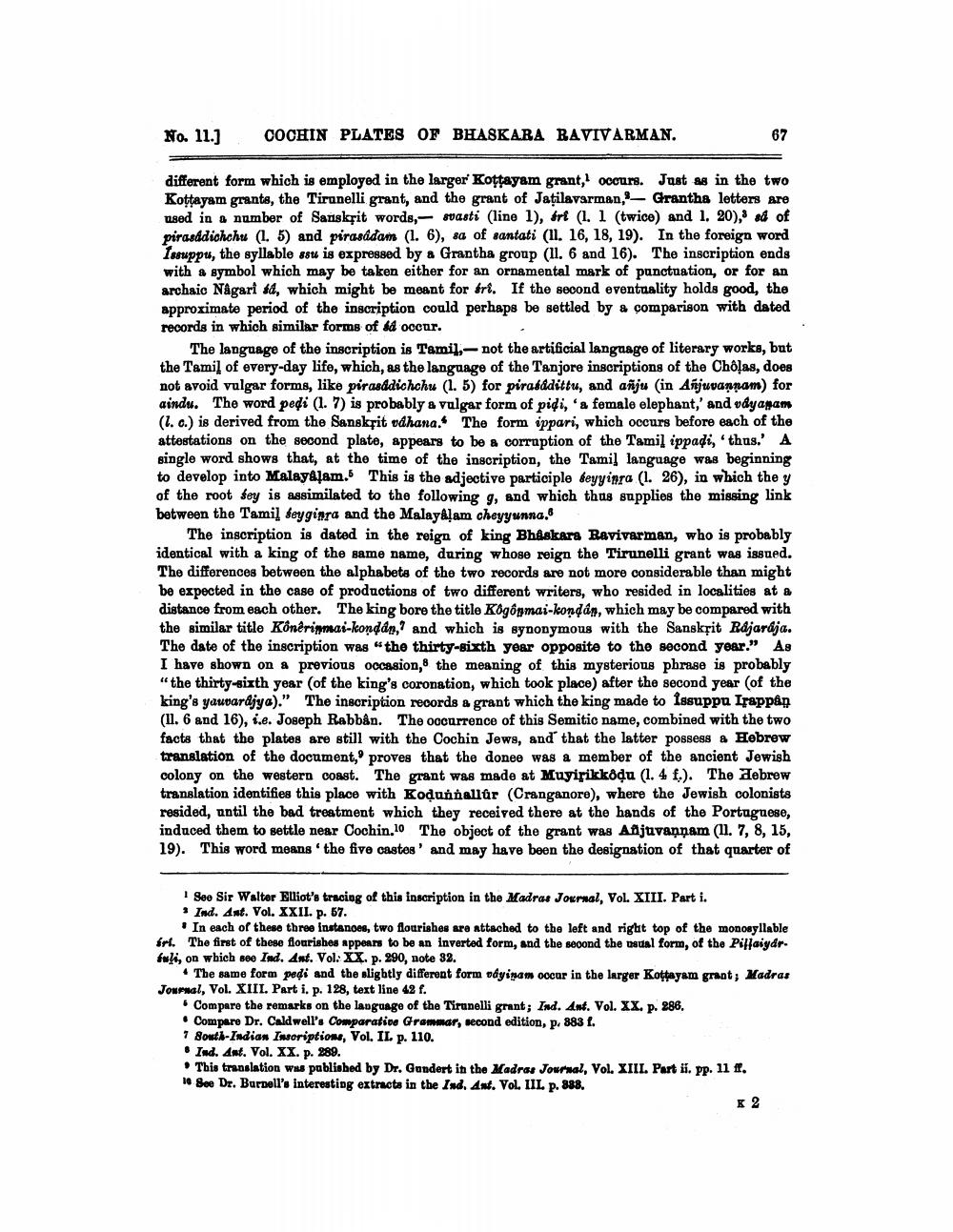________________
No. 11.]
different form which is employed in the larger Kottayam grant, occurs. Just as in the two Kottayam grants, the Tirunelli grant, and the grant of Jatilavarman, Grantha letters are used in a number of Sanskrit words,- svasti (line 1), ért (1. 1 (twice) and 1. 20), så of pirasádichchu (1.5) and pirasádam (1. 6), sa of santati (11. 16, 18, 19). In the foreign word Issuppu, the syllable ssu is expressed by a Grantha group (11. 6 and 16). The inscription ends with a symbol which may be taken either for an ornamental mark of punctuation, or for an archaic Nagari sd, which might be meant for ári. If the second eventuality holds good, the approximate period of the inscription could perhaps be settled by a comparison with dated records in which similar forms of sá occur.
COCHIN PLATES OF BHASKARA RAVIVARMAN.
The language of the inscription is Tamil,- not the artificial language of literary works, but the Tamil of every-day life, which, as the language of the Tanjore inscriptions of the Chôļas, does not avoid vulgar forms, like pirasddichchu (1. 5) for pirasddittu, and anju (in Añjuvannam) for aindu. The word pedi (1. 7) is probably a vulgar form of pidi, a female elephant,' and vayapam (1. c.) is derived from the Sanskrit vdhana. The form ippari, which occurs before each of the attestations on the second plate, appears to be a corruption of the Tamil ippadi, 'thus.' A single word shows that, at the time of the inscription, the Tamil language was beginning to develop into Malayalam. This is the adjective participle seyyinra (1. 26), in which the y of the root sey is assimilated to the following g, and which thus supplies the missing link between the Tamil seyginra and the Malayalam cheyyunna.
The inscription is dated in the reign of king Bhaskara Ravivarman, who is probably identical with a king of the same name, during whose reign the Tirunelli grant was issued. The differences between the alphabets of the two records are not more considerable than might be expected in the case of productions of two different writers, who resided in localities at a distance from each other. The king bore the title Kôgônmai-kondan, which may be compared with the similar title Kônêrinmai-kondán, and which is synonymous with the Sanskrit Rajaraja. The date of the inscription was "the thirty-sixth year opposite to the second year." As I have shown on a previous occasion, the meaning of this mysterious phrase is probably "the thirty-sixth year (of the king's coronation, which took place) after the second year (of the king's yauvarajya)." The inscription records a grant which the king made to issuppu Irappân (11. 6 and 16), i.e. Joseph Rabbân. The occurrence of this Semitic name, combined with the two facts that the plates are still with the Cochin Jews, and that the latter possess a Hebrew translation of the document,' proves that the donee was a member of the ancient Jewish colony on the western coast. The grant was made at Muyirikkôdu (1. 4 f.). The Hebrew translation identifies this place with Koḍunnallûr (Cranganore), where the Jewish colonists resided, until the bad treatment which they received there at the hands of the Portuguese, induced them to settle near Cochin.10 The object of the grant was Añjuvanņam (11. 7, 8, 15, 19). This word means 'the five castes' and may have been the designation of that quarter of
1 See Sir Walter Elliot's tracing of this inscription in the Madras Journal, Vol. XIII. Part i. Ind. Ant. Vol. XXII. p. 57.
67
In each of these three instances, two flourishes are attached to the left and right top of the monosyllable iri. The first of these flourishes appears to be an inverted form, and the second the usual form, of the Pillaiydr. fuli, on which see Ind. Ant. Vol. XX. p. 290, note 32.
The same form pedi and the slightly different form vdyinam occur in the larger Kottayam grant; Madras Journal, Vol. XIII. Part i. p. 128, text line 42 f.
• Compare the remarks on the language of the Tirunelli grant; Ind. Ant. Vol. XX. p. 286.
• Compare Dr. Caldwell's Comparative Grammar, second edition, p. 883 f.
7 South-Indian Inscriptions, Vol. II. p. 110.
Ind. Ant. Vol. XX. p. 289.
This translation was published by Dr. Gundert in the Madras Journal, Vol. XIII. Part ii. pp. 11 ff.
10. See Dr. Burnell's interesting extracts in the Ind. Ant. Vol. III. p. 338.
K 2




